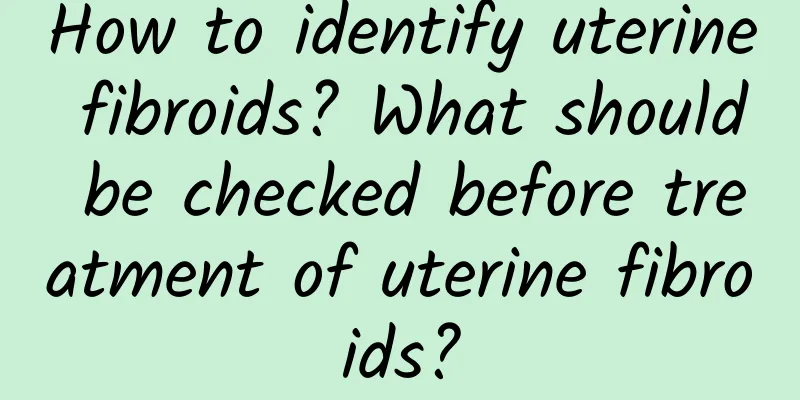How to identify uterine fibroids? What should be checked before treatment of uterine fibroids?

|
According to traditional Chinese medicine, uterine fibroids are caused by seven kinds of internal injuries, organ dysfunction, qi stagnation and blood stasis. Modern medical research has found that the amount of estrogen receptors in fibroid tissue is greater than that in normal uterine muscle tissue. It is suggested that the occurrence of uterine fibroids is related to endocrine disorders caused by long-term excessive estrogen levels. At the same time, hormone metabolism is controlled by advanced nerve centers, so nerve center activity may also play a very important role in promoting the disease. In addition, cytogenetic studies have shown that some fibroids have cytogenetic abnormalities, so it is recommended that use can achieve good results. The exact cause of uterine fibroids is still unclear, and it may be related to excessive estrogen levels in the body and long-term estrogen stimulation. Self-identification of uterine fibroids depends on these three points 1. Do you have abdominal pain? Attention should be paid to pain in the lower abdomen, back or sacrum, because sometimes pain is a self-exposure of uterine fibroids, which can cause abdominal pain due to compression of tissues, traction, pedicle torsion, rupture or degeneration by the tumor. 2. Is the leucorrhea abnormal? Normal leucorrhea is a small amount of slightly sticky transparent, egg white-like secretion, which is odorless and bloody leucorrhea appears more than four or five days before and after ovulation. The leucorrhea increases, and sometimes a large amount of purulent and bloody discharge and necrotic tissue will be produced. 3. Whether the menstrual volume increases If accompanied by long-term increase in menstrual volume, be alert to uterine fibroids. They mainly occur in submucosal and intramural fibroids, and manifest as menorrhagia, prolonged menstruation or irregular vaginal bleeding. The main reason for increased bleeding is the increase in endometrial area. Endometrial congestion hinders uterine contraction and affects blood circulation. Due to long-term bleeding, patients often have varying degrees of anemia. How to check before treating uterine fibroids? 1. Is there any pain? Patients will feel symptoms such as lower abdominal swelling and back pain. When the fibroid pedicle twists or the fibroid becomes red and degenerates, the abdominal pain will worsen. 2. Observe bleeding Common symptoms of uterine fibroids are irregular menstruation, irregular vaginal bleeding, etc. If the condition is severe, anemia may occur. 3. Touching the lump After defecating on an empty stomach in the morning, lie flat on the bed, bend your knees slightly, relax your abdomen, and press your lower abdomen with your hands to check if there is any lump. 4. Observe leucorrhea Under normal circumstances, leucorrhea is a white, sticky secretion. There will be slight changes in the menstrual cycle. Uterine fibroids can cause an increase in leucorrhea, which is pus-like and bloody, with a strange smell. 5. Compression symptoms Fibroids can compress the bladder, leading to symptoms such as frequent urination and urination disorders, and compress the rectum, leading to symptoms such as constipation and difficulty in defecation. Prevention of uterine fibroids starts with details 1. Regular physical examinations are an essential health amulet for female friends. If you find vaginal itching, increased secretions, odor, lower abdominal or back pain, you should be alert to gynecological inflammation and have a physical examination in time. 2. Develop good personal hygiene habits, clean the vulva correctly, and keep the vulva clean and dry. Avoid sexual intercourse when the inflammation has not been completely cured. In spring and summer, women should use sanitary pads as little as possible to avoid breeding bacteria and causing vaginitis or cervicitis; do not abuse care solution; do not wear tight underwear, and change underwear every day. The changed underwear must be washed separately and exposed to the sun to prevent cross infection. 3. Drink plenty of water, eat a balanced diet, eat more protein-rich foods such as fish, meat, eggs, soy products and fresh vegetables rich in vitamins, eat iron-containing foods, and avoid spicy, cold, high-fat and high-sugar foods. 4. When facing gynecological diseases, don’t panic or be careless. Go to the hospital for consultation and treatment in time, use medication correctly under the guidance of a doctor, and have regular check-ups to ensure recovery. |
>>: What are the treatments for uterine fibroids? What are the dangers of uterine fibroids?
Recommend
Will routine examination of ovulation bleeding and leucorrhea affect the results?
Will routine examination of ovulation bleeding an...
Bacterial vaginosis can recur if not treated promptly
Nowadays, more and more people may suffer from ba...
What are the treatments for adnexitis?
Although the treatment of adnexitis is rather tro...
Do patients with cervical erosion need to undergo cervical cancer screening once a year?
Do patients with cervical erosion need to undergo...
How long after induced abortion can I have sex?
How long after induced abortion can you have sex?...
How big is the gestational sac?
The size of the gestational sac is an important f...
Treatment of adnexitis is mainly through physical therapy
Physical therapy is the most common treatment for...
What medicine can cause abortion?
Usually, taking mifepristone tablets or misoprost...
Traditional Chinese medicine has different understandings on the occurrence of vaginitis
Traditional Chinese medicine has different views ...
If you don’t want to gain weight, walk 7116 steps every day!
Most obese people want to find a quick way to los...
Hospitals that treat congenital absence of vagina
Congenital absence of vagina is caused by the sta...
What medicine do I need to take to treat uterine fibroids? What medicine do I need to take to treat uterine fibroids?
Uterine fibroids are a common gynecological disea...
Why is cervical erosion hard to cure? 3 ways to completely treat cervical erosion
Cervical erosion is now very common. Many women c...
How to self-diagnose patients with cervical precancerous lesions
The most important duty of women is to get pregna...
How long can I have menstruation if my endometrium is 11mm?
How long does it take to get menstruation if the ...









